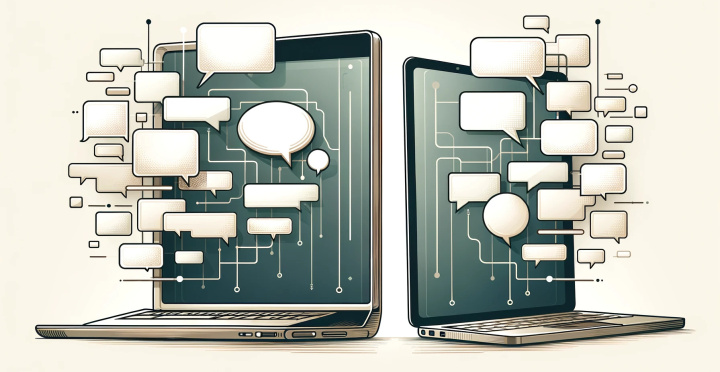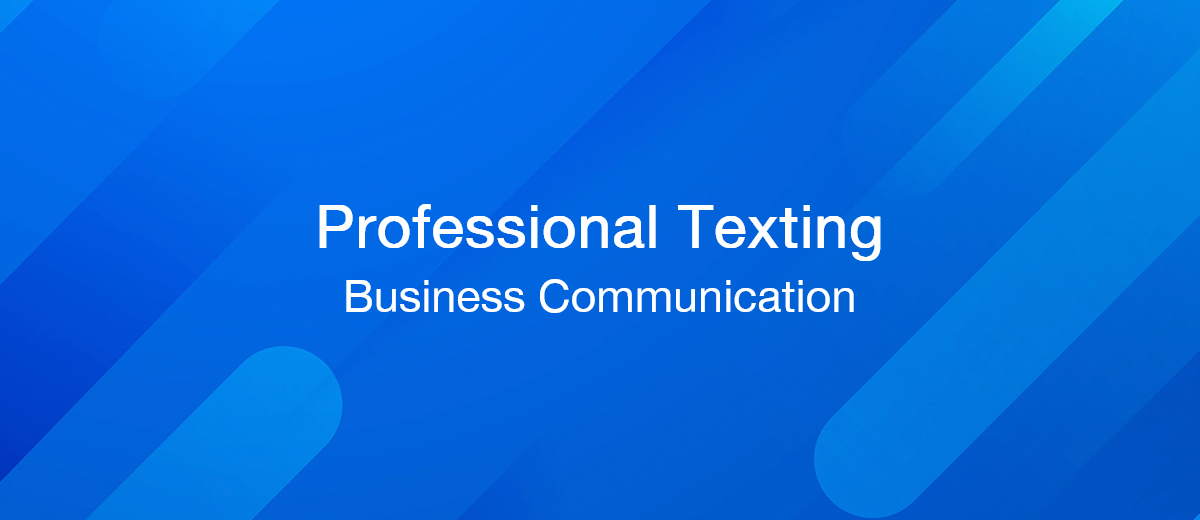Texting for Professionals: Best Practices for Business Communication
Is text messaging a hidden gem of modern business communication? In the rapidly changing landscape of professional interactions, it's time to explore the pivotal role that texting plays. Is it a versatile and efficient tool, or could it be more? This guide is your gateway to understanding the significance of texting in the business world, clarifying its purpose, and identifying the diverse audience it serves. Get ready to question and uncover the potential of business texting.
The Fundamentals of Professional Texting
Understanding the fundamentals of professional texting is essential for effective interaction. When it comes to context, recognizing when to opt for texting versus other channels ensures efficient and contextually appropriate communication. Additionally, audience analysis plays a pivotal role in the success of your messages, as tailoring your messages based on audience analysis can lead to improved engagement, better relationships, and ultimately, increased business success.
Maintaining the right tone and language is equally crucial, with the importance of professionalism in communication highlighted by a global survey of business professionals. Crafting messages that exude professionalism not only fosters trust but also positions you as a competent communicator within your industry. Furthermore, avoiding jargon and slang is key to clear communication, ensuring that your messages are accessible and easily comprehensible to a wider audience. Lastly, proper grammar and spelling are vital, as attention to detail in language usage goes a long way in conveying professionalism and competence.
9 Steps to Set up Your Business Texting for Effective Communication

Effective communication is the linchpin of business success. Business texting has emerged as a crucial tool in this landscape, offering a direct and efficient way to connect with customers, clients, and employees. To make the most of this communication channel, follow these key steps:
- Step 1. Choose the Right Platform: The foundation of effective business texting starts with selecting the right platform. You'll want to opt for a service or software that aligns with your unique business needs. Consider factors such as scalability, budget, and features like message automation and integration capabilities. The choice of platform will significantly impact the efficiency of your communication efforts.
- Step 2. Get a Dedicated Business Number: Maintaining professionalism and distinguishing between personal and business communication is paramount. Obtain a dedicated business phone number, which can be either a virtual number or an extension of your existing landline. This dedicated number allows multiple team members to manage texts, ensuring that no critical messages go unanswered.
- Step 3. Develop a Strategy: Success in business texting hinges on having a clear and well-defined strategy. Start by outlining your goals and identifying your target audience. Different types of messages may be required, whether they are promotional, informational, or related to customer support. Tailor your messaging to meet the unique needs and preferences of your intended recipients. A well-crafted strategy will provide direction for your messaging efforts and make your communication more effective.
- Step 4. Ensure Compliance: Business texting is subject to various regulations, such as the Telephone Consumer Protection Act (TCPA) in the United States and the General Data Protection Regulation (GDPR) in Europe. It is crucial to ensure strict compliance with these rules, as violations can lead to substantial fines. This entails obtaining the necessary consent from recipients and providing transparent opt-out instructions.
- Step 5. Personalize Messages: Personalization is the cornerstone of effective business texting. Avoid generic, one-size-fits-all messages that may be perceived as spam. Instead, use recipients' names and reference prior interactions whenever relevant. Personalized messages are more likely to capture recipients' attention and establish a stronger connection.
- Step 6. Automate Where Possible: Automation can significantly streamline your business texting processes, saving time and improving efficiency. Implement automated responses for frequently asked questions, appointment reminders, and order confirmations. Additionally, leverage scheduling tools to dispatch messages at optimal times, considering the recipient's time zone and preferences.
- Step 7. Monitor and Measure: To gauge the effectiveness of your business texting strategy, engage in regular monitoring and measurement. Most business texting platforms provide analytics that offer insights into message open rates, response rates, and conversion rates. This data is invaluable for refining your strategy and enhancing your communication over time.
- Step 8. Prioritize Customer Support: Texting can be a powerful tool for providing customer support. Ensure that your team is adequately trained to respond promptly and professionally to customer inquiries and concerns. Offering excellent customer support through text messaging can enhance your brand's reputation and foster customer loyalty.
- Step 9. Seek Feedback: Encourage feedback from your customers and clients regarding their experiences with your business texting. Their insights can be instrumental in identifying areas for improvement and fine-tuning your strategy. Act on their feedback to continuously elevate the quality of your communication.
Professional Texting Etiquette
Texting etiquette in a professional context is akin to the foundation of a well-constructed building. It ensures your messages are received positively and that your communication is effective. Let's explore the various facets of texting etiquette, complete with examples and tips to help you navigate this essential aspect of business texting.
A. The Art of the Subject Line
The subject line is your message's first impression, setting the tone for what follows. It should be concise yet informative, offering recipients a glimpse into the message's content. For example, if you're scheduling a team meeting, a subject line like "Team Meeting Confirmation for Friday" is far more effective than a vague "Meeting."
Tip: Keep subject lines brief and specific to grab attention. Avoid using generic subject lines like "Hello" or "Important."
B. Introduction and Greetings
Proper Salutations: The way you greet your recipients sets the tone for the conversation. Use appropriate salutations based on the level of formality and familiarity. For instance, "Dear Mr. Smith" is suitable for a formal business text, while "Hi John" is more casual and acceptable for colleagues you know well.
Tip: When in doubt, lean towards a slightly more formal greeting to maintain professionalism.
Brief Introductions: A brief introduction at the beginning of your text can provide context or remind the recipient who you are. For example, "Hi Jane, this is Alex from the marketing team" helps the recipient connect your name with your role.
Tip: Include introductions when necessary, especially in larger professional networks where not everyone may remember you by name alone.
C. Conciseness and Clarity
Avoiding Ambiguity: Clarity is paramount in business texting. Avoid vague or ambiguous language. For instance, instead of saying, "Let's meet sometime next week," specify a day and time, like, "Could we meet on Tuesday at 2 PM?"
Tip: Be explicit and specific in your messages to minimize misunderstandings.
Bullet Points and Lists: To convey information efficiently, consider using bullet points or lists. For example, when discussing project updates, you can list key milestones or tasks to be completed.
Tip: Break down information into easy-to-digest points, especially in texts with multiple details.
D. Emojis and Emoticons

Appropriate Use: Emojis and emoticons can add a touch of personality to your texts, but their use should be context-appropriate. For instance, a smiley face 😊 can convey friendliness, while a thumbs-up 👍 can signal agreement or approval.
Tip: Use emojis sparingly in professional texts and reserve them for situations where they enhance understanding or tone.
Overuse Caution: While emojis can be fun, excessive use can detract from your professionalism. For example, an entire message composed of emojis may not be suitable for a formal business discussion.
Tip: Keep emoji usage moderate and adapt it to the formality of the conversation.
How Can You Navigate Different Scenarios in Professional Texting?
In the professional texting, adaptability and effective communication are key. Different scenarios demand varying approaches to ensure your messages hit the mark. Let's delve into these scenarios, accompanied by practical examples and tricks to navigate them proficiently.
A. Texting for Meetings and Appointments
Scheduling and Confirming Meetings: Texting is a valuable tool for setting up appointments. For instance, you can use a text like, "Hi Sarah, can we schedule a meeting for next Thursday at 10 AM?" To confirm, simply reply, "Sure, Thursday at 10 AM works for me."
Trick: Include specific date and time options in your initial message to expedite scheduling.
Rescheduling and Cancellations: Sometimes, plans change. If you need to reschedule or cancel a meeting, text promptly with a polite explanation and offer alternative dates if possible. For instance, "I apologize, but I need to reschedule our meeting. How about next Tuesday at 3 PM instead?"
Trick: Always propose an alternative date to demonstrate your commitment to the appointment.
B. Texting for Client Communication
Updates and Progress Reports: Keeping clients informed is essential for building trust. Send regular updates, such as, "Our team has made significant progress on your project. We're on track to meet the deadline."
Trick: Use concise language and highlight key achievements to keep clients engaged.


Trick: Acknowledge the query first to reassure the client that you're addressing their needs.
C. Texting for Internal Team Communication
Project Updates: Keeping your team informed is vital for project success. Use texts like, "Team, we've completed Phase 1 ahead of schedule. Great work, everyone!"
Trick: Celebrate milestones to boost team morale and motivation.
Urgent Messages: In urgent situations, text concisely and clearly. For instance, "Urgent: Meeting with the client at 2 PM. Please prepare the presentation slides ASAP."
Trick: Clearly label urgent messages to grab your team's attention.
D. Dealing with Unpleasant Situations
Delivering Bad News: When delivering disappointing news, be empathetic and honest. For example, "I regret to inform you that the shipment is delayed due to unforeseen circumstances. We're actively working to resolve this issue and will keep you updated."
Trick: Offer a solution or alternative to mitigate the impact of bad news.
Handling Complaints: When faced with a client complaint, address it professionally and promptly. Acknowledge the issue, apologize if necessary, and propose a resolution. For instance, "I'm sorry to hear about the inconvenience you've experienced. We'll investigate this matter and ensure it's resolved promptly."
Trick: Act swiftly and demonstrate your commitment to resolving the problem.
How Can You Ensure Security and Data Privacy in Business Texting?

Safeguarding sensitive information is paramount in business texting. In
this section, we explore essential strategies and practices to ensure
the security and privacy of your communications.
A. Protecting Sensitive Information
Encryption and Secure Messaging: One of the fundamental pillars of data security in texting is encryption. Employ messaging apps and platforms that offer end-to-end encryption. This ensures that your messages are scrambled during transmission and can only be unscrambled by the intended recipient. It's akin to sending a letter in a locked box that only the recipient has the key to. For example, apps like Signal and WhatsApp utilize strong encryption protocols to safeguard messages against unauthorized access.
Instruction: Always verify that the messaging platform you use employs encryption to protect sensitive information from prying eyes.
Avoiding Data Leaks: Data leaks can have devastating consequences. To prevent accidental data exposure, double-check recipients before sending sensitive information. Utilize secure cloud storage and document sharing services when transmitting confidential files. Moreover, be cautious when sharing sensitive data over public Wi-Fi networks, as they may be vulnerable to interception.
Instruction: Implement policies within your organization to classify data and ensure employees are aware of what constitutes sensitive information.
B. Authentication and Verification
Two-Factor Authentication: Two-factor authentication (2FA) is an additional layer of security that ensures only authorized users gain access to your texting accounts. With 2FA, even if someone obtains your password, they won't be able to log in without the second authentication factor, typically a one-time code sent to your mobile device. Many messaging apps and platforms offer 2FA as an option to enhance security.
Instruction: Enable 2FA wherever possible to add an extra shield of protection to your texting accounts.
Identifying Suspicious Texts: In the digital world, not all messages are genuine. Be vigilant and cautious when receiving texts, especially those requesting sensitive information or immediate action. Verify the sender's identity if you receive an unexpected message requesting confidential data. Scammers often impersonate legitimate entities to trick recipients.
Instruction: If you suspect a message is fraudulent, do not respond or click on any links within the text. Instead, contact the organization directly through their official contact information to confirm the message's legitimacy.
How to Manage Record-Keeping and Compliance in Business Texting?
In the business texting, maintaining records and adhering to compliance regulations are essential components of responsible and professional communication.
A. Archiving Business Texts
Archiving business texts is a practice that not only promotes transparency but also ensures you have a historical record of critical conversations. Many businesses use archiving tools and services to securely store text messages for reference and compliance purposes. Keeping an organized archive allows you to revisit past conversations, track progress, and address disputes or discrepancies effectively.
B. Compliance with Regulations
GDPR, HIPAA, and Other Industry-Specific Regulations: Different industries have specific regulations governing data privacy and security. For example, the General Data Protection Regulation (GDPR) in Europe and the Health Insurance Portability and Accountability Act (HIPAA) in the healthcare sector impose stringent rules on how businesses handle sensitive data. Ensuring compliance with these regulations when texting is not only a legal obligation but also a commitment to safeguarding customer data.
Legal Requirements: Beyond industry-specific regulations, there are legal requirements that govern communication and data retention. Complying with these legal obligations is crucial. For instance, in certain legal proceedings, text messages may be considered evidence. Failing to maintain records in accordance with legal requirements can result in legal consequences for your business.
Improving Business Texting Skills
Improving your business texting skills is like sharpening a valuable tool. It's a process that never really ends, and it's essential for success in today's professional world.
Think of it like this: you don't stop learning and improving just because you've learned the basics. Business texting is the same. You should always be on the lookout for new ideas and ways to get better at it. You can do this by reading articles, attending webinars, and taking courses that focus on using text messages effectively for business. The key here is to stay open to learning and be willing to change and grow.
Imagine you're a chef trying to perfect a recipe. You'd ask people who've tasted your food what they think, right? It's the same with business texting. Don't be afraid to ask your colleagues, mentors, or trusted friends for feedback on your text messages. They can tell you what's working and what could be better. Also, take some time to look at your own messages. Did they do what you wanted them to do? Were they clear and professional? This self-assessment helps you see where you can improve.
Lastly, think of improving your business texting skills like building a house. You need the right tools, and in this case, those tools are resources. There are lots of books, courses, and guides out there dedicated to making you a better business texter. Many of them are free or don't cost much. By using these resources, you can learn new tips and tricks to become a pro at business texting. So, don't be afraid to explore and use what's available to you.
Conclusion
In wrapping up our exploration of business texting, let's quickly recap the best practices we've discussed. We've learned about the importance of proper etiquette, security, and compliance, as well as strategies for continuous improvement. Now, the key is to put these lessons into action. Use the knowledge you've gained to enhance your business texting skills and make your professional communication more effective.
As for the future, business texting tool is here to stay, evolving alongside technology and communication trends. Adopting it as a valuable tool for your career, and keep adapting to the exciting changes it may bring. Happy texting!
Apix-Drive is a simple and efficient system connector that will help you automate routine tasks and optimize business processes. You can save time and money, direct these resources to more important purposes. Test ApiX-Drive and make sure that this tool will relieve your employees and after 5 minutes of settings your business will start working faster.

